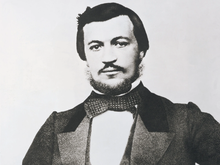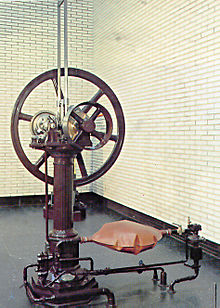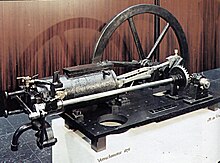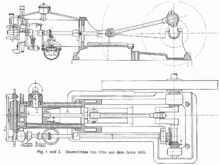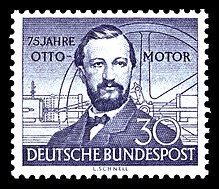Partnership with Eugen Langen
Early in 1864, Otto sought investors to fund his research. He found Eugen Langen, whose father was a sugar industrialist. Together they entered into a partnership on 31 March 1864 and named it NA Otto & Cie in Cologne. This was the world's first company focused entirely on the design and production of internal combustion engines.
The 1864 Otto & Langen engine was a free piston atmospheric engine (the explosion of gas was used to create a vacuum and the power came from atmospheric pressure returning the piston). It consumed less than half the gas of the Lenoir and Hugon atmospheric engines and so was a commercial success. The Lenoir engine was a double acting engine. In essence these engines are a steam engine altered to run on illuminating gas. The engines of Italian inventors Eugenio Barsanti and Felice Matteucci in their British Patent no 1625 of 1857, were built and are in a museum. Unlike Otto's engine these are two stroke atmospheric engines which are not in any way comparable.
For all its commercial success, with the company producing 634 engines a year by 1875, the Otto and Langen engine had hit a technical dead end as an atmospheric engine: it produced only 3 hp (2.2 kW; 3.0 PS), yet required 10–13 ft (3.0–4.0 m) headroom to operate.
Otto turned his attention to the four stroke cycle at which he had failed in 1862. Largely due to the efforts of Franz Rings and Herman Schumm, who were brought into the company by Gottlieb Daimler Otto succeeded in making the Four Stroke, Compressed Charge engine. It is this engine (the Otto Silent Engine), and not the Otto & Langen engine, to which the "Otto cycle" refers. This was the first commercially successful engine to use in-cylinder compression. The Rings-Schumm engine appeared in autumn 1876 and was immediately successful.
In summary, the Otto engine which is the predecessor of the modern engine as specified by the VDI is Otto's fourth design. He built the following engines:
- 1861: a copy of Lenoir's atmospheric engine
- 1862: a four cycle compressed charge engine (prior to Rochas's patent) which failed as it broke almost immediately
- 1864: the first successful atmospheric engine
- 1876: the four stroke compressed charge engine which is acknowledged as the "Otto" cycle engine. The term "Otto cycle" is applied to all compressed charge, four cycle engines.
Otto married Anna Gossi and the couple had seven recorded children. His son Gustav Otto grew up to become an aircraft builder.
